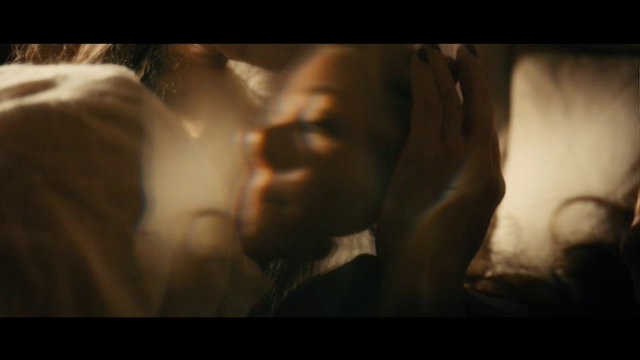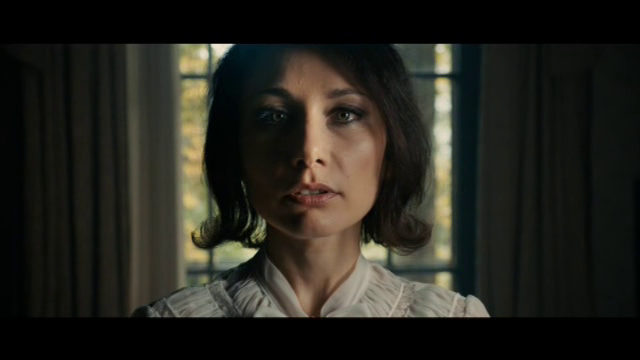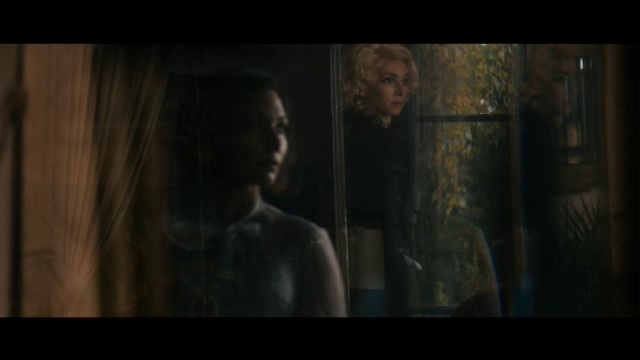Monthly Archives: April 2016
Summary of Discussion on The Duke of Burgundy
Many thanks to Frances for providing the below summary of the discussion following our most recent screening:
The post-screening discussion of The Duke of Burgundy focused primarily on the experience of watching this film, which is quite difficult to describe. The film itself is quite unconventional – with no firm narrative as such – and at times this makes for a challenging viewing experience, particularly at the beginning when Cynthia’s treatment of Evelyn appears abusive. Narrative comprehension aside, watching the film is a distinctive experience, with words such as compelling, hypnotic and intense being used to describe our feelings throughout. These affects are emphasised by the intense focus on nature within the film’s imagery and the repetition within the plot (as seen through Evelyn’s and Cynthia’s re-playing of scenarios), with some of these features compared to the work of Stan Brakhage.
Many of these observations were linked to the fact that Burgundy is a sensory experience: it evokes a haptic visuality. This is evident even within the film’s credits, which provide reference for costume, lingerie and perfume. It was noted that the latter is not unprecedented (Audrey Hepburn may have credited her perfumer) but here it seems the emphasis is less on brand potentiality and more on the importance of the film as a sensory engagement with the viewer. This appeal to the senses is evident throughout the film. For example, when the initial ambiguity regarding Evelyn’s and Cynthia’s relationship is resolved, the film focuses on the intimacy and sensual encounters between the couple, as when Evelyn caresses Cynthia’s skin and her silk chemise, passionately whispering (in a voice-over) her devotion and sexual attraction to her lover. Similarly, the texture of clothing is given particular attention. Cynthia’s preparation for the women’s roleplaying is revealed in detail, as she is seen transforming her appearance through tight clothing, make-up and wigs. The camera cuts to close-up and medium shots to portray the details of Cynthia pulling on her stocking over her thigh and putting on her high-heeled shoes. The voyeurism of such images is echoed by Evelyn’s actions, as she watches her lover change through the bedroom keyhole; the detailing of clothes touching skin is revealed to be an integral part of Evelyn’s sexual gratification. As such, Cynthia’s body – and how she dresses it – is fetishized on both narrative and visual levels.
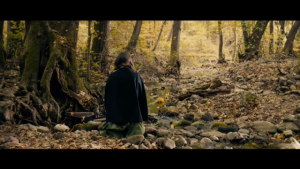 The emphasis the film places upon images of nature – as well as the titular insect – enhances this sensory experience further. This is established in the film’s opening shots which show Evelyn seated – with her back towards us – within a woodland area. The trickling of the water from the stream and the (unseen) birds in the trees dominant the soundtrack. Interestingly, the film does not resolve the mystery of the identity of this seated figure initially, as the film first cuts to a series of close-ups detailing the running water as it ripples around rocks in the stream. An edit back to the medium to long shot of Evelyn sees her turn her head upwards to the right, which then instigates a cut to a close-up of the sun shining through the trees, with the leaves gently rustling in the breeze. Such imagery helps to conjure up the experience of being in such a place: the sounds of wildlife and the smell of the damp soil in the air. This attention to detail is once again mirrored by the importance Evelyn places upon environments, textures, sights and sounds in the creation of her fantasies.
The emphasis the film places upon images of nature – as well as the titular insect – enhances this sensory experience further. This is established in the film’s opening shots which show Evelyn seated – with her back towards us – within a woodland area. The trickling of the water from the stream and the (unseen) birds in the trees dominant the soundtrack. Interestingly, the film does not resolve the mystery of the identity of this seated figure initially, as the film first cuts to a series of close-ups detailing the running water as it ripples around rocks in the stream. An edit back to the medium to long shot of Evelyn sees her turn her head upwards to the right, which then instigates a cut to a close-up of the sun shining through the trees, with the leaves gently rustling in the breeze. Such imagery helps to conjure up the experience of being in such a place: the sounds of wildlife and the smell of the damp soil in the air. This attention to detail is once again mirrored by the importance Evelyn places upon environments, textures, sights and sounds in the creation of her fantasies.
The use of this imagery also illuminates several tensions at work within the film’s narrative and its viewing experience. This is embodied by the film’s opening: specific features are depicted in some detail (like the running water) and yet Evelyn’s identity remains obscure and is not initially resolved by her first interactions with Cynthia (we only learn later that these events are orchestrated). More broadly, the film has no real sense of place or time – despite the detailing of the environment – and yet the narrative is still anchored by a specificity in locations, with the action occurring between the house, the grounds, the lecture room and the library. The nature scenes evoke connotations of a larger ecology – of life going on elsewhere – as is implied by Evelyn’s question during the Lepidoptera lecture about ‘other regions’. And yet these references to the outside world are contained by the film’s concentration on Evelyn’s and Cynthia’s relationship: the women’s world may be in an unknown location and time, but it is one which is consistent and insular. The intense focus through which we observe Evelyn’s and Cynthia’s lives evokes a feeling of claustrophobia, which is enhanced again through repetition: the lovers re-play their sadomasochistic scenarios again and again (with the same dialogue and actions), and images are also repeated, such as the close-ups of the pinned moths in Cynthia’s study, and the shots which depict Evelyn arriving at the house on her bicycle. This appeal to a sense of claustrophobia parallels Evelyn’s desire to feel smothered by her lover, which culminates in her introduction of the trunk into her sexual activities with Cynthia.
These aspects also point to the tensions which exist between Evelyn and Cynthia, and their relationship to broader ideas about the Gothic heroine. The film complicates our initial assessment of the connection between the women by revealing Cynthia’s apparent maltreatment of her maid to be the carefully choreographed and scripted rituals of Evelyn’s submissive desires. The power dynamics are further complicated by the fact that it is not Evelyn who is therefore the oppressed female protagonist but rather Cynthia, who becomes increasingly uncomfortable and overwhelmed by Evelyn’s insistence on playing these games and controlling Cynthia totally, including how she looks and what she says. Both women, therefore, embody different ideas we have discussed previously about how Gothic heroines are portrayed. Significantly, as with other Gothic films, the house plays an integral part in this: indeed, it is Evelyn’s anticipation from arriving at the front door and being kept waiting before being admitted to the house which a key part of her fantasy, signalling the beginning of her sexual interaction with Cynthia.
It is also interesting that whilst the intensity – and potential destruction – of the women’s relationship is emphasised throughout, Burgundy does not follow the peaks and troughs in emotion associated with melodrama and other Gothic films, such as Rebecca (1940). The intensity of the above tensions is maintained with only very subtle variations in mood: Cynthia’s emotional breakdown is indicated by several close-up shots of her looking dejected by Evelyn’s escalating requests, criticisms of her performance and feelings of betrayal when it is revealed Evelyn has polished another woman’s boots. Indeed, Cynthia’s apparent revenge for Evelyn’s behaviour is portrayed in an understated manner, as she deliberately wears the pyjamas Evelyn hates (rather than the revealing lingerie) and deviates from Evelyn’s script. The moment does not feature an outpouring of emotion or confrontation but is perhaps even more disturbing because of this: Cynthia covers Evelyn’s mouth with her foot when she attempts to say the lovers’ safe word pinastri. Evelyn silently weeps as Cynthia mocks her efforts to stop the roleplay in a scene which depicts the only time Cynthia appears to abuse Evelyn for real.
As argued in the introduction to the film, Burgundy’s relationship to the ‘queerness’ of the Gothic is revealed by these tensions, which act as reminders to the importance of the Gothic heroine within these discussions on the genre as a mode of storytelling. Burgundy takes these discussions further by challenging our assumptions and previous experience of who the Gothic heroine is and the relationship she has with the house. This point is underlined by the film’s ambiguous ending. Diane Waldman argues that, within the Hollywood Gothic films of the 1940s, the ending would reveal whether the heroine’s perspective had been validated or invalidated (a conclusion reflected by whether the film was pre or post-war) (Waldman, 1984). In Burgundy, it is difficult to ascertain whose perspective has been ‘validated’ and whether the film’s (and its characters’) investigation into the women’s relationship has actually revealed and resolved anything. In the final scenes, Cynthia finally breaks into tears and Evelyn begs her forgiveness and love saying she will do ‘anything’ to prove her devotion. The following montage shows the women sleeping in the bed together, the trunk being removed and Evelyn’s scripts and instructions being burnt. There seems to be a fresh understanding between the women and a renewed affection, as reflected by the shots which superimpose the women’s faces during their embrace. A voice-over narration hears Evelyn reassure Cynthia that ‘everything is fine’. Yet this montage ends with an edit to Evelyn seated back within the woodland area, with only the sounds of her environment audible on the soundtrack. The roleplaying game – and the film – repeats again, with Evelyn cycling towards the house and Cynthia putting on her tight skirt and wig. Significantly, we do not dwell on the moment Evelyn arrives and is kept waiting at the door – an action we know from previous occurrences is integral to Evelyn’s gratification. Rather, the final shot focuses on Cynthia as she gazes longingly into the mirror. It is an ambiguous moment which questions Evelyn’s assertion that ‘everything is fine’: is Evelyn controlling an unwilling Cynthia again? Will these actions inevitably follow the tensions previously experienced? Or have the women established a relationship based on equality and mutual respect and understanding? Burgundy once again subverts expectations and, in a truly Gothic manner, leaves such meanings up to personal interpretation.
References
Waldman, D. (1984). “At last I can tell it to someone!” Feminine Point of View and Subjectivity in the Gothic Romance Film of the 1940s.” Cinema Journal, 23 (2): 29-40.
Melodrama Screening and Discussion, 4th of April, 5-7pm, Jarman 7
After a brief break for the Festival of Projections Passages of Gothic installation, we return to the previously advertised screening schedule. All are very welcome to join us for the last of this term’s Screening and Discussion sessions, which will take place on Monday the 4th of April, 5-7pm, in Jarman 7.
We will be showing Frances’ choice The Duke of Burgundy (2014, Peter Strickland, 105 mins). Frances has very kindly provided the following introduction:
Peter Strickland’s The Duke of Burgundy (2014) is a film not easily classified. Upon its release, critics contextualised the work within European art cinema traditions, with comparisons to Luis Buñuel and Ingmar Bergman, as well as noting the influences of 1960s and 70s sexploitation films (Collin, 2015; Foundas, 2014). Strickland, himself, concurs with this broad range of inspiration, noting how, amongst others, he was inspired by films such as A Virgin among the Living Dead (1973) and Belle de Jour (1967) (Strickland, 2015). I propose that another way to interpret this challenging and compelling film is to think about it within the traditions of the Gothic. If we reflect upon the Gothic tropes and motifs discussed over the course of the term, it becomes clear how Burgundy may be analysed in this fashion. The film is set in an undisclosed place at an unknown time and – as indicated by the film’s opening scene – the narrative focuses upon the action taking place in and around the house. The film begins with Evelyn sitting alone in a woodland and the title sequence takes place as we follow Evelyn as she journeys from this peaceful area towards the large, dominating house. Upon arrival the non-diegetic whimsical music abruptly stops and the sounds of Spring audible elsewhere on the soundtrack – such as birds singing – suddenly convey a different, more menacing tone. Evelyn rings the doorbell and waits anxiously as the footsteps within take some time to finally arrive. When they do Evelyn is faced with a stern-looking Cynthia at the door who coarsely reprimands her: ‘You’re late’. Silently Evelyn walks through the door towards the dark gloom of the house within.
The emphasis upon the house and the interactions of the heroine within it, is only one way Burgundy draws upon the traditions of the Gothic. There are other motifs which we have seen in the Gothic films screened previously appearing here: the importance of a key; the idea of secrets to be uncovered and hidden places; the imperilled woman who, in this case, appears to be oppressed and abused; and the heroine’s exploration of the domestic space within darkness. Indeed, Burgundy features a memorable moment when Evelyn gets out of bed in the middle of the night– whilst significantly dressed in a white nightie – and ventures into the dark cellar, lighting her way with a candelabra. This iconic image of the investigative heroine is one we have seen numerous times in the other Gothic films watched, as reflected by the several examples we included in our Passages of Gothic installation two weeks ago. In this way, Burgundy appears to be another return to the Gothic which is evident elsewhere within contemporary cinema: the year after Burgundy sees the release of Ex Machina and Crimson Peak (both 2015). These films echo the Gothic in comparable ways as Ex Machina evokes the Bluebeard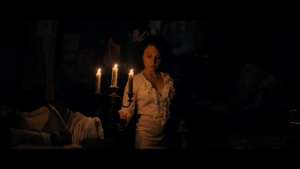 tale in its translation of the Gothic heroine into an android in a science-fiction story, whilst Crimson Peak mirrors the familiar tale of a woman marrying a man she hardly knows in manner evocative of Rebecca (1940), albeit with events now taking place in a period setting.
tale in its translation of the Gothic heroine into an android in a science-fiction story, whilst Crimson Peak mirrors the familiar tale of a woman marrying a man she hardly knows in manner evocative of Rebecca (1940), albeit with events now taking place in a period setting.
Ex Machina and Crimson Peak are reminders of the Gothic’s roots, particularly in respect to the centrality of relationships between men and women within the narrative’s trajectory. It is here that Burgundy differs. Evelyn and Cynthia are a lesbian couple and the story focuses on the dynamics of their sadomasochistic roleplaying in which Evelyn is the willing submissive. More broadly, Burgundy explores the relationships between various women within the film, with these interactions being alternately sexual, romantic, friendships, business transactions or scientific discussions. In Burgundy’s world, there are no men at all; indeed, even the mannequins which are part of the audience for the Lepidoptera lectures are female. The absence of a male figure may signal an alternative interpretation of the Gothic mode but this should not be read as a 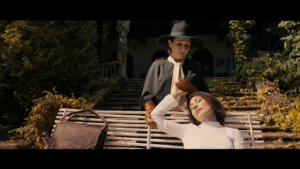 new, radical opposition to the Gothic ‘norm’ (if such a concept exists). In fact, it can be said that Burgundy harkens back to past themes and representations which can be analysed through the theories of queer Gothic.
new, radical opposition to the Gothic ‘norm’ (if such a concept exists). In fact, it can be said that Burgundy harkens back to past themes and representations which can be analysed through the theories of queer Gothic.
Queer theory and the Gothic have shared tendencies insofar as both emphasise contrary readings and the importance of subtext. George Haggerty pushes this idea further, arguing that the Gothic ‘offers a historical model of queer theory and politics: transgressive, sexually coded and resistant to dominant ideology’ (Haggerty, 2006, 2). Brian Robinson traces a similar historical connection, noting that ‘[t]he queer is inscribed in the DNA of Gothic fiction’ (Robinson, 2013, 143). This genealogy is one which the cinema inherits and capitalises upon because, as Robinson continues, it ‘was on film that the tropes of the Queer Gothic would find their full flowering’ (143). The queer readings possible – or, arguably, inevitable – of The Picture of Dorian Gray (1945) and the numerous adaptations of Dracula (1897), along with cinema’s continued fascination with vampires, strongly supports this assertion. The female Gothic can also be contextualised within this lineage: the importance of the Gothic heroine’s relationship with the archetypal ‘other woman’ begins to illuminate how such films can be interpreted through queer readings. A key example of this is the new Mrs de Winter’s discovery of the obsessive behaviour of Mrs Danvers towards her previous mistress in Rebecca (1940).
Burgundy brings to the fore the implied interpretations and queer subversions which have a historical precedent within cinema’s Gothic. In this way, the film becomes an embodiment of the uncanny: the return of the repressed which is, as Freud writes, unheimliche because this element ‘is actually nothing new or strange, but something that was long familiar to the psyche and was estranged from it only through being repressed’ (Freud, 1919, 148). Mair Rigby explores how the Gothic is queer – and how queer theory is Gothic – through the dialectics of the uncanny. Rigby argues:
When I say that queer scholarship’s encounter with the Gothic is ‘uncanny’, I mean that it appears to be based on a sense of a ‘secret encounter’ in which the texts bring to light something that ought to be repressed, something that feels particularly pertinent to people whose identities, bodies, and desires have been culturally designated ‘queer’. (Rigby, 2009, 48)
Burgundy presents this ‘bringing to light’ quite overtly through the portrayal of a world without men and in the detailing of alternative sexual practices which form an integral part of pivotal scenes between Evelyn and Cynthia. The fact that the most explicit forms of these acts remain off-screen only emphasises further their unheimliche nature: they are both familiar and normalised – we meet The Carpenter who specialises in building sadomasochist contraptions – and strange and marginal, as reflected by the way these practices are pushed to the periphery of the frame. Most importantly for Burgundy, however, is how the uncanniness of the story draws attention to the dynamics of the relationship between Evelyn and Cynthia, which is fraught with difficulties. By presenting us with two Gothic heroines, the film returns us to the central questions which orbit the archetypal female protagonist within this mode of storytelling: is the house a safe space or a danger? Within the romantic relationship, who holds the knowledge and the power? Whose secret is to be uncovered? What forms of oppression must the female protagonist(s) struggle against? Burgundy therefore revisits the ‘queerness’ of the Gothic and the significance of the Gothic heroine, although the film offers some surprising answers to the questions above: just like the ‘repressed’ returning to the light through the processes of the uncanny, so too does Burgundy remind us how what we initially think of as familiar or unusual, may quickly become conversely strange and homely.
References
Collin, R. (2015). The Duke of Burgundy: ‘Sexy and Strange’. [Online]. The Telegraph. Available from: http://www.telegraph.co.uk/film/duke-of-burgundy/review/ [Accessed 30 March 2016].
Foundas, S. (2014). Film Review: The Duke of Burgundy. [Online]. Variety. Available from: http://variety.com/2014/film/festivals/film-review-the-duke-of-burgundy-1201331373/ [Accessed 30 March 2016].
Freud, S. (1919). The Uncanny. In: Freud, S. (2003). The Uncanny. London: Penguin Books Ltd.
Haggerty, G. (2006) Queer Gothic. Urbana: University of Illinois Press, 2006.
Rigby, M. (2009). Uncanny Recognition: Queer Theory’s Debt to the Gothic. Gothic Studies, Volume. 11 Issue 1.
Robinson, B. (2013). Queer Gothic. In: Bell, J (Ed). Gothic: The Dark Heart of Film. Witham: Colt Press.
Strickland, P. (2015). Peter Strickland: Six Films that Fed into The Duke of Burgundy [Online]. BFI. Available from: http://www.bfi.org.uk/news-opinion/news-bfi/features/peter-strickland-six-films-fed-duke-burgundy [Accessed 30 March 2016].
Thanks very much for the introduction Frances! Do join us, if you can, for what sounds like a fascinating Gothic film many of us will have been intrigued by whilst watching the Passages of Gothic installation.

